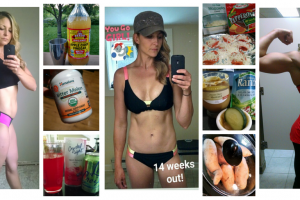Going Competitive As A Female
When looking for advice or tips on competing in strength sports, it can be difficult to find a resource for female athletes. This is because many sports like bodybuilding, weightlifting and CrossFit are dominated by males (ref 1). Even items like clothing, equipment and compression support are marketed mainly to men.
This is even in the case for sports with a lot of females present. Many administrations of a female-dominant sport are, ironically, also dominated by men (ref 2).
This can create a big problem. Women have different bodies and physiology than men. Because of this, they respond and adapt to exercise in different ways (ref 3). It also means that women can hold unique advantages and disadvantages to men.
This means that certain training and competition practices may benefit women more than men. Knowing them can help improve everything from overall mood and health to helping you train and perform optimally.
So, we put together some tips that can help any female athlete who is deciding to compete in strength sports.
4 Things To Know When Going Competitive As A Woman
1. You may start seeing oral contraception as your friend (and a tool for performance)
The use of contraceptives in sport is a very under-discussed issue. One of the biggest considerations for female athletes is their menstrual cycle. This will be discussed in detail below. Basically, the menstrual cycle in women causes changes in certain hormones.
This can affect everything from mood to the processing of nutrients, to performance in competition. Oral contraceptives help regulate and stabilize these hormones (ref 4). This can help make your training and performance more consistent.
So, continuing your oral contraceptive use may help remove unpredictability in training. This can then maintain performance in during a competitive season. This can create a shift in mentality when becoming competitive. You may start seeing contraceptives as a useful tool, rather than an addition to your lifestyle.
2. You’ll need to listen to your body and prioritize recovery
Just like the female body brings advantages, it can bring some drawbacks too. Amenorrhea can be a big problem for female competitors. This is the loss of a regular period.
This is a sign that your diet is too restrictive (ref 5), or your training and competition is too intense (ref 6). But, as a new athlete, taking a break from training or a competition may not be an option.
So, listening to your body and increasing food (particularly fat) intake can help boost health and performance. Incorporating other recovery interventions like compression shirts or calf compression sleeves (ref 7), as well as increased sleep (ref 8) can further help keep you competing.
This new shift of focus from exercise to recovery as a priority can be tough for competitors. But, you need to remember that the whole reason you’re training now is so you can be at your best at a competition. This is true whether you’re a bodybuilder, weightlifter or CrossFitter.
3. You’ll need to focus more on your diet and training (and your menstrual cycle)
This is an especially important tip for female bodybuilders. But, it is also vital for any athlete. Optimizing your diet and training for competition will be given much more attention. This is another change to when you were a recreational athlete.
If you’re not taking contraceptives, your menstrual cycle will also play a much greater role in this than just letting you know when you’re pushing it too hard.
Organizing your diet and training around different phases of your period can help boost fitness and performance. So, this will naturally become a key focus when you start competing.
For training, look at increasing your training volume in the first two weeks of your cycle, then decreasing it for the last two weeks (ref 9). This can give you greater gains in strength and muscle than just doing the same volume throughout the month.
For your diet (ref 10), increase fat intake and cut down carbohydrates for the first two weeks. Then, ramp up carbohydrates and cut fat (preferably saturated fat) for the final two weeks.
This can help you lose more weight than a conventional diet and may help boost fat loss. The reason for these benefits lies in the shift in hormonal balance your body goes through during your period. These above-mentioned shifts can change the fuel your body focuses on for its energy (from fat to carbohydrates).
So, if you’re getting ready to compete, remember that your diet and training will receive a whole new focus. Adapting both to your cycle can afford you a unique training and competitive advantage not available to male athletes. ( Read more in the article Using Your Menstrual Cycle to Optimize Diet and Training)
4. You’ll learn that fat is (also) your friend
As mentioned above, women adapt to exercise differently to men.
One different adaptation women experience with weight training is an increase in Type 1 muscle fibers.
These are endurance-type fibers that use more fat for fuel compare to their power-based type 2 fibers.
This, along with shifting hormones, means that women metabolize fat more efficiently than men (ref 11). They also store more essential fat.
Fat also has an a role in anabolic hormones like estrogen and testosterone production (ref 12). This makes a strong case for its inclusion in your diet. This is especially true if you’re a strength or power athlete. Fats may also help preserve anabolic hormone levels when cutting weight (ref 13). This makes it beneficial for bodybuilders.
There’s also value in carbohydrates for bodybuilders and weightlifters. The type of training performed by these athletes does rely on certain sugar compounds, such as glycogen, to fuel the muscles. While healthy fats are your friend, be mindful that healthy carbs are as well.
This is a big shift in mindset from the “fat is bad” and “carbs are the devil” viewpoint taken by many fitness enthusiasts. But, when you’re training for optimal performance in competition, there’s little room for tradition and dogma.







What are your thoughts? Comment below.